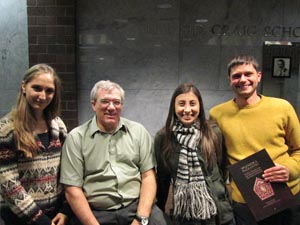Aleek Karkazian
Staff Writer

Photo: Barlow Der Mugrdechian
Lively chatter filled the spacious Alice Peters Auditorium in the University Business Center at Fresno State on the evening of January 28th. More than 100 Fresno state students, alumni, and members of the Fresno community, of varying ages and ethnic backgrounds, had gathered to hear Dr. Ronald Marchese’s lecture entitled “Treasures of Faith: Sacred Objects from the Armenian Churches of Constantinople and What They Tell Us About Armenian Society and Culture,” the first of the Armenian Studies Program Spring 2013 Lecture Series.
Dr. Marchese, a Fresno State alumnus, centered his lecture upon research he and his colleague, Dr. Marlene Breu, had conducted on sacred objects found in Armenian churches in Istanbul. The fundamental idea behind Dr. Marchese’s lecture was that objects inherently reflect the social and religious beliefs of their makers. Sacred art found in the Armenian churches of Constantinople are reflections of the beliefs of its people. According to Dr. Marchese, the collection of sacred objects found in the Armenian churches in Constantinople, “confirm…the interconnection between material culture, social identity, artisan-ship, and communal beliefs.”
For Armenians living in Constantinople, a predominantly Muslim city, the commissioning and formation of sacred objects were ways of expressing their intense commitment and dedication to their Christian beliefs. The process of making sacred objects was a pious act, “a personal statement of faith, whose purpose was to serve, honor and glorify God.”
After 1461, Armenians were encouraged to immigrate to Constantinople and their numbers there greatly increased. As the population increased, the number of Armenian neighborhoods and churches also increased. Dr. Marchese used a map that revealed the presence of clusters of churches in close proximity to one another, especially in areas near the Patriarchate, which reflects how important church and Christianity were in the lives of Armenians living in Constantinople.
The influence of the culture of Constantinople led to the formation of the unique style of Armenian religious or sacred art. However, Armenians were not only influenced by Constantinople but they influenced Constantinople culture in return. The constant migration of Armenians from different areas of Western Armenia continuously brought in new regional and sub-regional styles to refresh and enhance the tired Byzantine material culture found in Constantinople.
At first, it was the churches that were patrons for artisans to create objects of faith, but eventually, the amira class (the Armenian aristocracy) replaced the church as patrons. The amiras donated significant amounts of money for the construction of churches, but much of the contributions of sacred objects were from faithful “everyday” churchgoers who were not necessarily wealthy like the amiras.
Donations of sacred objects served the function of enhancing social standing and family prestige. Almost every sacred object that was commissioned for the church had an inscription that stated the individual’s name and family, so that the rest of the community would recognize their donation.
Dr. Marchese read several examples of inscriptions to the audience and explained that these inscriptions can be used to study the changing social structures of the time.
The new types of sacred objects being donated to the church also reflect the changing social structure. Unlike illuminated manuscripts made by monks in isolated monasteries in rural environments, laymen in urban environments were producing most of the sacred objects being made during this time. Now, in addition to the illuminated manuscripts made by monks, metalworkers and jewelers produced metalwork and women created textiles.
The textiles created by Armenian women often depicted biblical scenes and were miniature and three-dimensional in nature. Facial expressions were smaller than the size of thumbnail, and because the women producing them were so skilled, they were able to produce shading on such a small scale and in such a difficult medium. The textiles were three dimensional due to the incorporation of precious metal and jewels, and multiple layers of thread were necessary to produce such richly detailed scenes. Examples of textiles are: stoles, collars and tapestries. Like the textiles, the metalwork was also extremely detailed and often depicted biblical scenes. Examples of the silver and metal work included: standards, chalices, crosses, incense holders and reliquaries, large alter pieces, and crowns.
Dr. Marchese talked about the brilliance of Armenian sacred art, particularly in the textiles, throughout his lecture, but it wasn’t until he showed examples of the extremely detailed and exquisite metalwork and textiles produced by the Armenian artisans that the audience could truly appreciate this fact. The amount of care and skill that went into the production of these objects is a testament to the deep dedication these Armenian artisans had to their craft, the Armenian community and to their faith.
 Hye Sharzhoom Armenian Action
Hye Sharzhoom Armenian Action